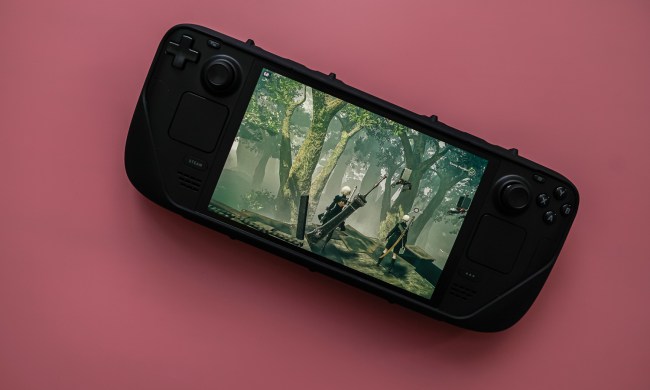Not too long ago, the only major choice that gamers had to make when buying a new device was whether they wanted a PC or a console. These days, the choice is made trickier with a third option. Valve’s Steam Deck is the device that started this revolution by introducing PC gaming to portable handhelds, but it’s no longer alone on the battlefield — new contenders keep popping up to vie for the attention (and dollars) of gamers worldwide. That brings us to Lenovo’s latest invention, the Legion Go portable PC.
While the Steam Deck and the Lenovo Legion Go share a lot of similarities, the new handheld also has a lot in common with the Asus ROG Ally, not to mention the Nintendo Switch. But how does it compare to the Steam Deck? Let’s explore them both below and find out.
Pricing and availability

Steam Deck has already been around for a while, and we’ve since seen the launch of several gaming handhelds, including the pricier Asus ROG Ally (read our Steam Deck versus ROG Ally comparison), and the way, way pricier Ayaneo 2. So far, it’s looking like Valve will continue to have the upper hand here when compared to Lenovo, at least as far as pricing goes.
Valve launched the Steam Deck on February 25, 2022, and the interest was high right away — people had to reserve it ahead of time and wait for the console to be shipped to them. The handheld is available in three flavors, starting at $400 for the 64GB version with an eMMC, followed by $530 for the 256GB version that bumps the storage up to an NVMe SSD, and $650 for the top spec with 512GB of storage. Paying extra simply gets you more storage; the Steam Deck performs identically otherwise.
Lenovo’s Legion Go will, for now, only be available in one version, but it seems very likely that another model might be released shortly after (or even at the same time). The release date is set for October 2023, and the console will cost $700 at minimum. That makes it significantly more expensive than the Steam Deck, but it almost sounds affordable when compared to the Ayaneo 2S, which is priced at $1,300.
Design

At first glance, both handhelds look somewhat similar. They also both rely on AMD-made hardware to run. However, the specs couldn’t be more different, and there are some major differences in the design, too.
For starters, the Lenovo Legion Go is much bigger, weighing 1.88 pounds with the controllers attached and measuring 11.8 by 5.15 by 1.61 inches. While the Steam Deck is similar in size (11.7 by 4.6 by 1.9 inches), it’s a lot lighter, weighing in at approximately 1.47 pounds. The heavier device might get tiring for users who enjoy a long gaming session, since it’s a hefty brick to carry around and game on. Just for comparison, the Nintendo Switch with Joy-Cons attached weighs around 0.88 pounds, and even that can get heavy after a couple of hours.
Design-wise, the Steam Deck adopts a standard ABXY button layout that’s shared by the Legion Go. It also has a D-pad, left and right analog triggers and bumpers, two analog sticks, and four assignable grip buttons. It features a trackpad on each side as well, whereas Lenovo only comes with one. However, the Legion Go also serves up a large D-pad and 10 mappable shoulder inputs, including buttons, triggers, and grip buttons. There’s also an innovative angled mouse wheel that comes in handy if you’re into esports titles, especially first-person shooters (FPS).
That’s the interesting part, really — that the Lenovo Legion Go seems to take inspiration in equal parts from the Steam Deck and the Nintendo Switch. Why? Because, unlike the Steam Deck, the Legion Go comes with detachable controllers, and one of those controllers can serve as a makeshift mouse to make FPS games a reality. Lenovo appears to have taken the familiar concept of detachable Joy-Cons and run with it to close the gap between PC gaming and consoles.

The way this feature works is that the right controller can be placed in a magnetic ring that keeps it upright. In that position, it resembles a mouse with left and right buttons, and there’s also a wheel to enable scrolling. To support this type of design, the handheld comes with a kickstand that lets you set it down and play while only holding the joysticks. That could make it easier to game for hours, given the weight of the device, but it’s hard to say whether the controls will feel smooth or clunky.
Lastly, there’s the screen, which belongs in a whole different league from the Steam Deck. The Lenovo Legion Go comes with an 8.8-inch QHD+ IPS display, meaning a resolution of 2,560 x 1,600 with a 16:10 aspect ratio, and it offers refresh rates maxing out at 144Hz. It’s pretty bright, too, with a peak brightness of 500 nits.
For comparison, the Steam Deck has a 7-inch IPS screen with a resolution of 1,280 x 800 and a refresh rate of 60Hz. The brightness maxes out at 400 nits. While this sounds like a clear win for the Lenovo Legion Go, this kind of power could be to its detriment. High resolution, brightness, and refresh rate will surely drain the battery quickly.
Specs

Both the Steam Deck and the Lenovo Legion Go turned to AMD for one of its APUs to power up their portable PCs. However, it’s impossible to deny that the Lenovo handheld is likely capable of reaching far greater heights, all thanks to the much-improved AMD chip that it houses.
Let’s take a look at how these two devices compare on paper, spec-by-spec.
| Steam Deck | Lenovo Legion Go | |
| Processor | AMD Zen 2 APU | Up to AMD Ryzen Z1 Extreme |
| Graphics | RDNA 2 | RDNA 3 |
| Memory | 16GB 5,500 MT/s LPDDR5 | 16GB 7,500 MHz LPDDR5X |
| Storage | 64GB (eMMC) / 256GB / 512GB (NVMe SSD) | 256GB / 512GB / 1TB PCIe NVMe M.2 SSD |
| Operating system | SteamOS | Windows 11 |
| Battery | 40Wh | 49.2Wh |
| Ports | 3.5mm audio jack, 1x USB Type-C, microSD | 3.5mm audio jack, 2x USB Type-C, 1x microSD |
| Connectivity | Wi-Fi (2.4GHz and 5GHz), Bluetooth 5.0 | Wi-Fi 6E, Bluetooth 5.2 |
| Display | 7″ (1,280 x 800) IPS 60Hz | 8.8″ QHD+ (2,560 x 1,600) IPS 144Hz |
The main difference lies in the chip, although the Lenovo Legion Go also has a better battery and improved connectivity, including access to Wi-Fi 6E and Bluetooth 5.2. The AMD APU in the Steam Deck has much more modest specs, featuring four Zen 2 cores and eight threads, with a clock speed maxing out at 3.5GHz. The graphics are also one generation older, with eight RDNA 2 compute units (CUs) that can hit 1.6GHz at most.
Lenovo used the same Z1 Extreme processor that’s in the ROG Ally, so it’ll feature eight Zen 4 cores and 12 RDNA 3 cores. That’s bound to give it a noticeable edge over the Steam Deck, but we’ll have to wait and see how it performs once it’s officially out.
The operating system also marks a change — while Valve introduced its own SteamOS for the Deck, Lenovo relies on Windows 11, which is a familiar interface, but could have its pitfalls if it’s not configured well to match this new format.
Performance

In theory, both handhelds are meant to be capable of running the most demanding games at a satisfactory level. The Steam Deck, while not without fault, can handle the most popular titles, although the settings may need some tweaking. Playing AAA titles on Max settings is a pipe dream on a PC as small as this, but the small resolution certainly helps.
We’re not sure yet how the Lenovo Legion Go will compare to the Steam Deck in terms of performance, but we’ve already caught one possible problem — the impressive 1600p resolution. In our early testing, the console was struggling when faced with a game played at the maximum resolution. For comparison, the Asus ROG Ally only runs at 1080p, and even that can be a lot to handle. We’ll just have to wait and see how the Legion Go performs when it’s out, especially at native resolution.
We’ve tested the Asus ROG Ally against the Steam Deck and found it to be up to 50% faster at 800p. This should come as no surprise given the massively improved chip. Since the Legion Go houses the same APU, it should have similar capabilities — in theory. But the resolution could really throw a wrench into things and make it underperform, at least on paper.
Extras

What’s a portable PC without an additional bag of goodies? While none of these items come with the handheld itself, both the Steam Deck and the Legion Go have some accessories. They’ll cost you extra, but they can add a certain level of entertainment or comfort to using your console. On the entertainment side, Lenovo seems to be winning by far right now.
Alongside the Legion Go, Lenovo announced the Legion Glasses. These glasses were made to be worn while gaming on the handheld or other compatible devices, which, as Lenovo teased, include most Windows, Android, and macOS devices that support USB-C. Lenovo refers to them as “an advanced wearable virtual monitor with micro-OLED display technology.” It honestly sounds a bit like a VR headset without the VR, as it projects a large FHD screen for each eye with a 60Hz refresh rate. Again, it feels like closing the gap between having a laptop and a console.
The Steam Deck is less flashy by comparison, offering up a handy dock instead of a pair of glasses. The Docking Station props up the console, lets you connect the device to external displays (including a huge TV), and adds several connectivity options. Valve makes its own docking stations, but there are also lots of aftermarket options to choose from, as well as other interesting Steam Deck accessories to peruse.



